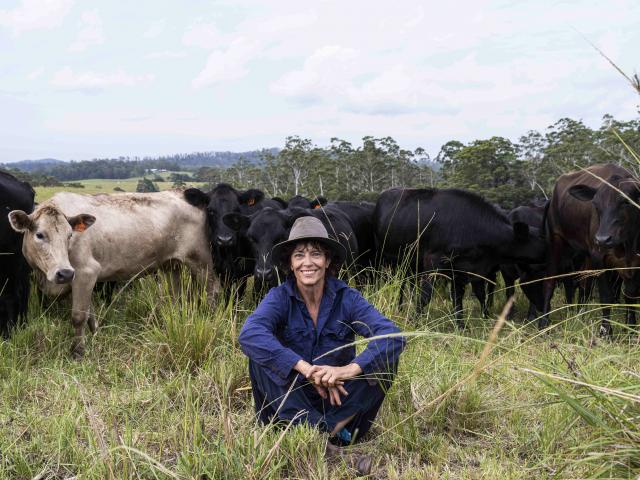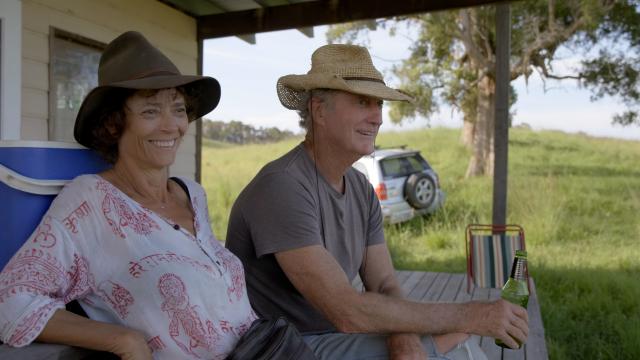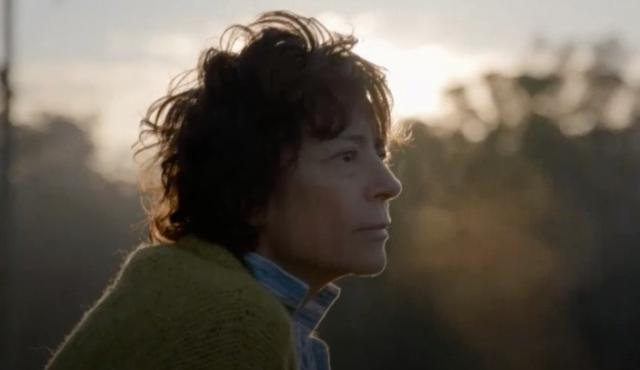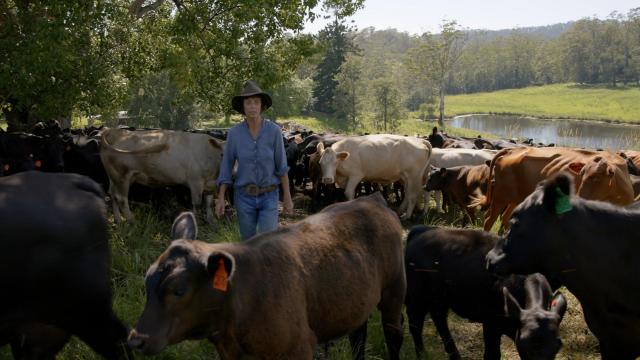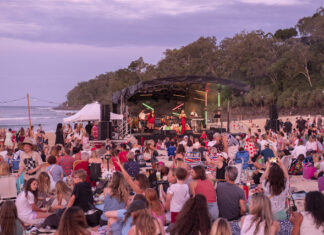Film director and actress Rachel Ward is heading to Noosa this month for screenings of her movie Rachel’s Farm.
Born in the UK and with an early career in modelling, she is not the first person you’d expect to join a farming revolution.
In 1984, she starred in the iconic TV series The Thorn Birds, which glamorised the rugged Australian Outback.
The whole world fell in love with it, and Rachel fell in love with her Australian co-star, Bryan Brown. And of course, Australians fell in love with Rachel.
The two married and moved to Australia and several years later they bought a farm in the Nambucca Valley, in the Mid North Coast of New South Wales.
There, they have raised cattle and their three children, endured droughts, and flooding rains and finally the catastrophic bush fires of 2019-20, which threatened Rachel’s farm and devastated the country.
Neighbouring farmer and farm manager Mick Green shared her view that conventional farming was no longer working, and together they discovered that neither of their farms were ecologically or financially viable.
Slow Food Noosa is bringing Rachel’s Farm to the region in conjunction with Noosa District Landcare, Tarwyn Park Training and Kandanga Farm Store.
In a first for Queensland, screenings at Pomona’s Majestic Theatre on Thursday, 24 August, at 6.30pm, then at BCC Cinema Noosa
at 6.30pm Friday, 25 August, will be followed by a panel discussion featuring the actress/director.
Slow Food Noosa and Noosa and District Land Care have offered farmers a Regenerative Farming and Rewilding Grant for the past two years.
Slow Food Noosa’s Karyn Lees said that when it was announced Rachel Ward had just released the film on her journey with regenerative farming, the committee knew they had to ask to bring it up here.
“We feel so excited that Rachel said yes.
“It is also so exciting that we have the depth of talent and knowledge in our terrific discussion panels.”
Pomona screening: Moderator, Amber Scott. Panel: Hamish Andrews, Forage Farms; Tim Scott, Kandanga Farm Store; Penny Kennedy, Sunshine Organics.
Noosa screening: Moderator, Dr Saskia De Klerk. Panel: Stuart Andrews, Tarwyn Park Training; Amber Scott, Kandanga Farm Store; Victoria Kane, Nutritionist.
In a phone interview on Friday, the actor, director and now farmer Rachel said the film was about transforming her cattle property into a carbon-sequestering, biodiversity haven through regenerative farming practices.
It’s a glimpse into how agriculture and our food system can be harnessed as a powerful solution to climate change that’s good for us, for farmers, and for the planet.
“My inspiration came from reading Charles Massy’s book, Call of the Reed Warbler,” she said. “It details the challenges and accomplishments of many early adopters of the regenerative way of farming.
“I was galvanised by the heroics of these farmers’ stories, many of whom had gone bust from farming conventionally in ever degenerating soils and increasing droughts.
“I too hit a wall in the summer of 2019-20 when, after a three-year drought which forced me to buy feed, then sell half my herd … I was surrounded by Black Summer fires.
“I lost all my fencing and my faith in any miracle arriving to save our country from destruction.
“With the very pressing realities of climate change and a new grandson I was galvanised to take meaningful action with not only the way I farmed but, as a filmmaker, how I could employ my skills to spread the word about the most hopeful response to climate change that I had ever encountered.”
Rachel met Bryan Brown while working on The Thorn Birds.
Thirty six years ago they made a film in the Nambucca area – The Umbrella Woman – and bought the farm.
“We were sticky-beaking around the area and found this beautiful 100 acres and I couldn’t say no.
“We started with an old wooden clapboard house; it had been a piggery.
“We would go there every school holiday period.
“It was a wonderful lifestyle retreat – inconvenient as it was six hours from Sydney – but we loved it and the kids had holidays there.
“We had 30 to 60 head of cattle and when the neighbour sold we bought a bit more land, increased the house and 36 years later we are running 300 head.”
Their herd is mainly Angus but Rachel has moved into South African breeds such as Senapol and Mashona as they’re better with sub-tropical conditions.
There is a lot of setaria on the property, she said, and they are not the best pastures.
“We went more for the South African breeds of cattle as they are more pest resistant. There is a buffalo fly problem.”
So how does an actress and now film director like dealing with dung beetles as a way of improving the soil and cutting the breeding cycle of buffalo flies?
“I like healthy pastures. If you don’ have dung beetles, the alarm bells ring.
“We were concerned about the lack of dung beetles, so we went off shopping and bought some.
“They improve the land but they’re very seasonal – there are no winter dung beetles here but we are trying to get more.”
Rachel sees this documentary as a personal account of one woman’s journey in the transition from conventional/industrial to regenerative farming as a very real response to climate catastrophe.
“It’s going really well,” she said. “Feature documentaries don’t hang around forever but the Q&As have been mostly sold out.
“Climate change needs a positive story and this is one of them.
“It answers questions on climate change and where we are headed.
“Regenerative farming is the most hopeful thing … the way of bringing carbon from air and into the soil.”
The change of lifestyle to the Nambucca Valley farm meant the family could slow down, be in nature, read nature, understand what’s going on.
The difference to the farm is that it now has a re-wilded look.
While the turning point was the cycle of drought, floods and fire, the costs of inputs in farming are also forcing change to more sustainable practices.
“People don’t tend to embrace change very readily, unless the method you’re using is unravelling or you can’t do something.
“We came to the point where it wasn’t viable ecologically or financially. That’s what made us change.
“We had the fire and all our fences were incinerated, so we took the opportunity then to make the change.
“It’s a small coastal farm so the economies of scale don’t serve us very much.”
As well as their three children having grown up with the farm, Rachel said they were reaching out to a new circle of friends in the community.
“There are not a lot of regenerative farmers in my area. Some … but a holistic management course introduced me to some local farmers and the process of change.”
While the Nambucca area is similar to the Mary Valley and Noosa hinterland in regards to a sub-tropical environment, Rachel has to contend with leached soil – low in potassium, boron and minerals.
“We need to do everything we can to increase our pastures. There are no winter perennials.
“We need an intense herd of cattle … hooves on the ground trampling, knocking down long grasses.”
A big change with the property has been going from 30 paddocks to 90 through better fencing techniques, but also water supply.
“We move the cattle, like mimicking nature,” Rachel said, “… maybe every couple of days, depending on how much grass there is.
“We have that sorted in regard to rotation of cattle.
“There are now water points in all the paddocks – dams feed into header tanks and then into troughs.”
Rachel enjoys being an outdoors person and working with nature rather than against it. And loves nothing better than getting her hands dirty.
“I love working with the cattle.
“I love the physicality of being outside. I love the control.
“You can’t control the weather or the markets but you can control everything else. In the film industry you cannot control anything.
“I’m not the best farmhand but I’m getting there.
“I’m very good at making things happen. I like to get cracking.
“Mick likes a good chat … he has the big ideas, whereas I’m saying ‘let’s do it.’
“I’m dogged.”
Rachel came up with the idea for the film after being driven by feeling very impotent and wanting to make a change.
“I was having climate anxiety and being very concerned, especially having a grandchild.
“By experiencing climate shocks and events quite frequently, I was thinking about what it is going to be like in 100 years.
“That gave me a lot longer view. Basically we are making the farm more resilient, the pastures more robust … letting nature do whatever she can to put her into a stronger position for when we get long droughts, fires or flooding. Mainly the droughts.
“What we are doing is drought-proofing. If you can put enough carbon back into the soil … that holds the water so it acts like a sponge.
“You can rehydrate the land with this way of looking after it.
“People are getting their heads around a lot of this, particularly by using cover crops and not leaving the soil bare.
“Reducing tilling … I know it’s hard to give up pesticides, herbicides and synthetic fertilisers but there are certainly other ways in which early-adopters have had extraordinary results.
“It’s a holistic approach, there is not a silver bullet.”
Rachel has completed a Stuart Andrews course held at Kandanga Farm Store about holding the water on the land, so is no stranger to the region.
Regenerative farming is a bonding, she said, an area where everybody is deeply interested and passionate about this way of looking after the land.
“All the challenges it presents but all the excitement as well.
“There are others on the same journey to talk to.”
Regenerative changes to farming have allowed Rachel to reflect on other areas in her life.
“I wanted to do this as I was so ignorant of where our food came from.
“Three years ago I had little knowledge or interest about how my food was grown. I think about the difference between holistically-grown produce that is biologically produced rather than relying on chemicals.
“Fresh, local food has different taste … you cannot compare it.”
What was interesting was the food chain; how locked in the system was with some of the corporate retailers being able to get food produced cheaper and cheaper.
But what is that cost in regard to human health, and ecological health?
“That made me aware of the type of food I want to eat. The more I focus on food that comes from best practice farms, the more I can support them. How I can encourage best practice farms.”
Ways to find out about these farms and producers is to look at Sustainable Table, an environmental not-for-profit that provides Australians with the tools and information to make ethical eating easy.
There is a map on the Rachel’s Farm website as well.
“All the farms that produce organic food, regenerative, permaculture, whatever, are on that map and we are hoping more and more will register, as it’s a great way to work outside of the system.”
Since Covid gave a great wake-up call in regard to supply chains, production and transport, people have gone back to convenience rather than commitment or community.
As the standard of living increases, the first thing people drop is healthy food,” Rachel said.
“It really is a question of economies of scale as the more we encourage this kind of farming, the more people will do it and the cheaper it becomes.
“I’m not sure how much government can do in this – it’s very controlled and very much up to consumer demand.
“If consumers demand healthier food, if consumers want to see farming made more holistic and serving the environment, the more that they want that the more that things will change.”
As Australia moves towards more trade with the European Union there is the fact the EU has much higher regulations – tighter, stricter.
“Only by demand from the markets and consumers, will things change. People will have to start delivering that.”
Questions consumers need to ask are: What are the costs of cheap food? What price is good health?
It becomes expensive if we end up with poor diet and nutrition.
“We just look at the food on our plate.
“I have three areas to impact change – as farmer, film producer and consumer.
“Understanding what’s on our plate, where that food has come from, how we can influence things.
“Every meal we make can make a change – how our food is grown, we can influence climate change.
“Think about where it is grown, about engaging in best practice.
“Now we have goodness and nutrients coming up through the ground and into the food … and that is very empowering.”
Rachel believes her new role is someone in search of answers to the world of regenerating and rehydrating landscapes and sequestering carbon.
“I see the fight to address climate change as the most pressing concern of my lifetime and will engage every ounce of my ability and time I have left to help spread the word on the extraordinary potential of building back soils to their former stable, biodiverse, complex selves.
“This film is one woman’s story as she tries to undo the damage she has done to her farm through ignorance, leading her to a journey of education leading to repair, regeneration, as well as a little bit of frustration and impatience.
“This is a journey of hope where my grandson’s future is made possible if we act now to make the changes.
“I think one of the most powerful things that you can do is to know your farmer.
“The more people that farm this way, the more we’re going to heal our landscapes. I feel incredibly hopeful.”
WHAT IS REGENERATIVE AGRICULTURE?
“At its core, regenerative agriculture is about restoring and enhancing ecosystem function on farms and in landscapes through practices designed to work with the landscape, climate, people and livestock.” (NSW Department of Primary Industries, 2021).
Regenerative agriculture means different things to different people, with an array of practices employed depending on the context.
These practices have the potential to reverse climate change by building healthy, biologically-diverse and mineral-rich soils, all the while sequestering carbon from the atmosphere.
Across the world, smallholder farmers, broad-acre farmers and graziers are now employing agricultural methods that reverse the loss of soil health, heal landscapes, hold water and bring agriculture and food back to life.
Regenerative food systems include agroforestry, agroecology, silvopasture, pasture cropping, advanced rotational grazing and crop diversification.
Most of these methods have been used by Indigenous cultures for many thousands of years.
Regenerative agriculture’s underlying principles include:
● eliminating bare soil and avoiding tillage
● fostering plant diversity
● using more perennials
● encouraging water percolation into the soil
● integrating livestock and cropping.
BOOKINGS:
Pomona’s Majestic Theatre at 6.30pm on August 24 – www.trybooking.com/CKLXW
Noosa’s BCC Cinemas at 6:30pm on August 25 – www.stickytickets.com.au/514DB

